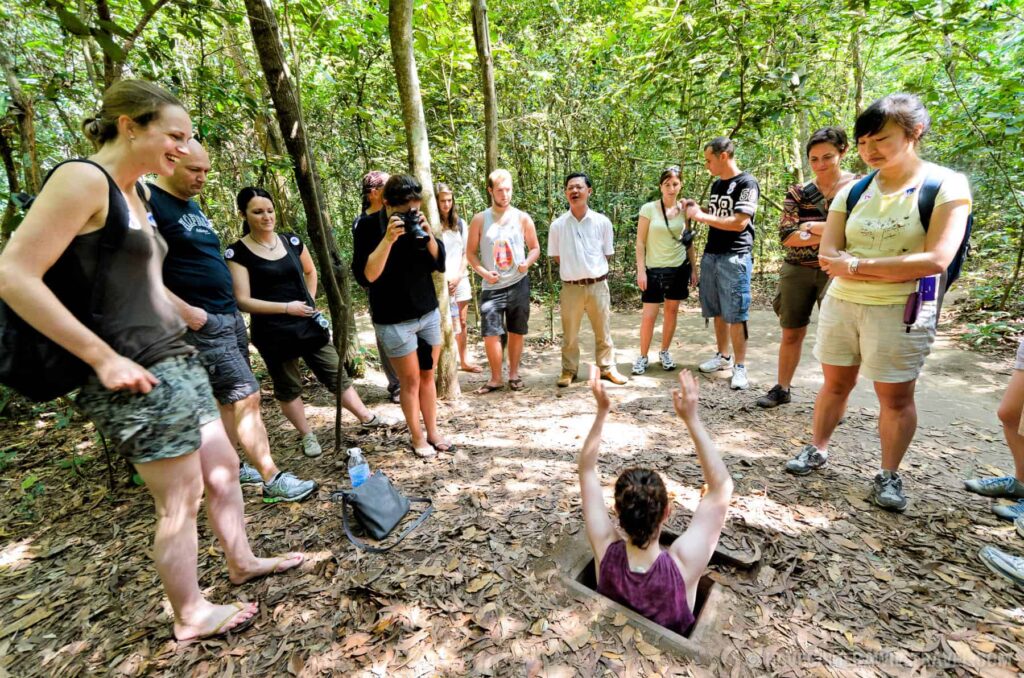Welcome back to VNAround (vnaround.com) – more than a blog, we’re your Viet guide to uncovering Vietnam’s fascinating history and culture. Today, let’s journey into one of Vietnam’s most iconic historical sites: the Cu Chi Tunnels. These underground passages played a crucial role in the country’s resistance during the Vietnam War, and their story is one of ingenuity, resilience, and courage.
1. What Are the Cu Chi Tunnels?
Overview
The Cu Chi Tunnels are an extensive network of underground tunnels located about 70 kilometers northwest of Ho Chi Minh City. They stretch over 250 kilometers and were built by the Viet Cong forces during the Vietnam War as a base for military operations.
Structure
The tunnels are a multi-level system that includes living quarters, kitchens, meeting rooms, storage areas, and even hospitals.
2. The Role of the Tunnels in the Vietnam War
A Strategic Advantage
The Cu Chi Tunnels gave the Viet Cong a significant tactical advantage. They allowed soldiers to launch surprise attacks, evade capture, and maintain their resistance despite heavy bombardments from U.S. forces.
Survival in Harsh Conditions
Life in the tunnels was harsh. Soldiers endured limited oxygen, food shortages, and the constant threat of discovery. Yet, their determination turned these tunnels into a symbol of resilience.
3. How the Tunnels Were Built
Ingenious Engineering
The tunnels were dug by hand, using simple tools and an extraordinary amount of labor.
- Narrow Entrances: Designed to fit only the smaller frames of Vietnamese soldiers, making it difficult for larger foreign troops to enter.
- Trap Doors: Camouflaged entrances and exits were hidden in plain sight, often beneath leaves or soil.
- Booby Traps: Various traps were strategically placed to deter enemies.
Ventilation and Smoke Dispersal
Innovative ventilation systems allowed air to circulate underground, while kitchens had special chimneys that dispersed smoke far from the cooking areas.
4. Visiting the Cu Chi Tunnels Today
Two Main Sites
There are two main locations where visitors can explore the tunnels:
- Ben Dinh Tunnels: Closer to Ho Chi Minh City, offering a more compact experience.
- Ben Duoc Tunnels: Larger and less crowded, showcasing a more authentic layout.
What to Expect
- Crawl through sections of the tunnels to experience the cramped conditions.
- See displays of booby traps, weapons, and artifacts used during the war.
- Learn about the daily life of Viet Cong soldiers through guided tours and historical exhibits.
5. Tips for Your Visit
Best Time to Visit
The dry season (November to April) offers comfortable weather for exploring the tunnels.
What to Bring
- Comfortable clothing and sturdy shoes.
- Water and sunscreen for outdoor areas.
- A camera to capture the historical displays and surroundings.
Guided Tours
Hiring a guide enhances your visit by providing detailed insights into the history and significance of the tunnels.
6. Why the Cu Chi Tunnels Are More Than Just Tunnels
A Testament to Resilience
The Cu Chi Tunnels are a reminder of the ingenuity and perseverance of the Vietnamese people during one of the most challenging periods in their history.
A Living History Lesson
Walking through these tunnels offers a tangible connection to the past, providing visitors with a deeper understanding of the struggles and sacrifices made during the war.
Explore Vietnamese street food
At VNAround (vnaround.com), we encourage you to explore the Cu Chi Tunnels not just as a tourist attraction, but as a journey into Vietnam’s spirit of resilience and ingenuity. These tunnels are more than historical relics; they are a tribute to the courage and determination of the Vietnamese people.
Let us know your thoughts after visiting the Cu Chi Tunnels, and stay tuned to VNAround for more historical and cultural explorations! 🌏



